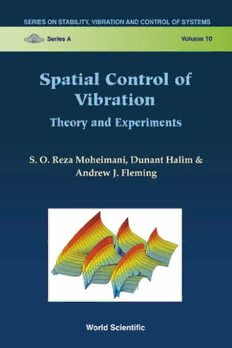Download Spatial Control of Vibration: Theory and Experiments PDF Free - Full Version
Download Spatial Control of Vibration: Theory and Experiments by S. O. Reza Moheimani, Dunant Halim, Andrew J. Fleming in PDF format completely FREE. No registration required, no payment needed. Get instant access to this valuable resource on PDFdrive.to!
About Spatial Control of Vibration: Theory and Experiments
Vibration is a natural phenomenon that occurs in a variety of engineering systems. In many circumstances, vibration greatly affects the nature of engineering design as it often dictates limiting factors in the performance of the system. The conventional treatment is to redesign the system or to use passive damping. The former could be a costly exercise, while the latter is only effective at higher frequencies. Active control techniques have emerged as viable technologies to fill this low-frequency gap. This book is concerned with the study of feedback controllers for vibration control of flexible structures, with a view to minimizing vibration over the entire body of the structure. The book introduces a variety of flexible structures such as beams, strings, and plates with specific boundary conditions, and explains in detail how a spatially distributed model of such systems can be obtained. It addresses the problems of model reduction and model correction for spatially distributed systems of high orders, and goes on to extend robust control techniques such as H-infinity and H2 control design methodologies to spatially distributed systems arising in active vibration control problems. It also addresses other important topics, such as actuator and sensor placement for flexible systems, and system identification for flexible structures with irregular boundary conditions. The text contains numerous examples, and experimental results obtained from laboratory-level apparatus, with details of how similar test beds may be built.
Detailed Information
| Author: | S. O. Reza Moheimani, Dunant Halim, Andrew J. Fleming |
|---|---|
| Publication Year: | 2004 |
| ISBN: | 9789812383372 |
| Pages: | 236 |
| Language: | English |
| File Size: | 10.351 |
| Format: | |
| Price: | FREE |
Safe & Secure Download - No registration required
Why Choose PDFdrive for Your Free Spatial Control of Vibration: Theory and Experiments Download?
- 100% Free: No hidden fees or subscriptions required for one book every day.
- No Registration: Immediate access is available without creating accounts for one book every day.
- Safe and Secure: Clean downloads without malware or viruses
- Multiple Formats: PDF, MOBI, Mpub,... optimized for all devices
- Educational Resource: Supporting knowledge sharing and learning
Frequently Asked Questions
Is it really free to download Spatial Control of Vibration: Theory and Experiments PDF?
Yes, on https://PDFdrive.to you can download Spatial Control of Vibration: Theory and Experiments by S. O. Reza Moheimani, Dunant Halim, Andrew J. Fleming completely free. We don't require any payment, subscription, or registration to access this PDF file. For 3 books every day.
How can I read Spatial Control of Vibration: Theory and Experiments on my mobile device?
After downloading Spatial Control of Vibration: Theory and Experiments PDF, you can open it with any PDF reader app on your phone or tablet. We recommend using Adobe Acrobat Reader, Apple Books, or Google Play Books for the best reading experience.
Is this the full version of Spatial Control of Vibration: Theory and Experiments?
Yes, this is the complete PDF version of Spatial Control of Vibration: Theory and Experiments by S. O. Reza Moheimani, Dunant Halim, Andrew J. Fleming. You will be able to read the entire content as in the printed version without missing any pages.
Is it legal to download Spatial Control of Vibration: Theory and Experiments PDF for free?
https://PDFdrive.to provides links to free educational resources available online. We do not store any files on our servers. Please be aware of copyright laws in your country before downloading.
The materials shared are intended for research, educational, and personal use in accordance with fair use principles.

